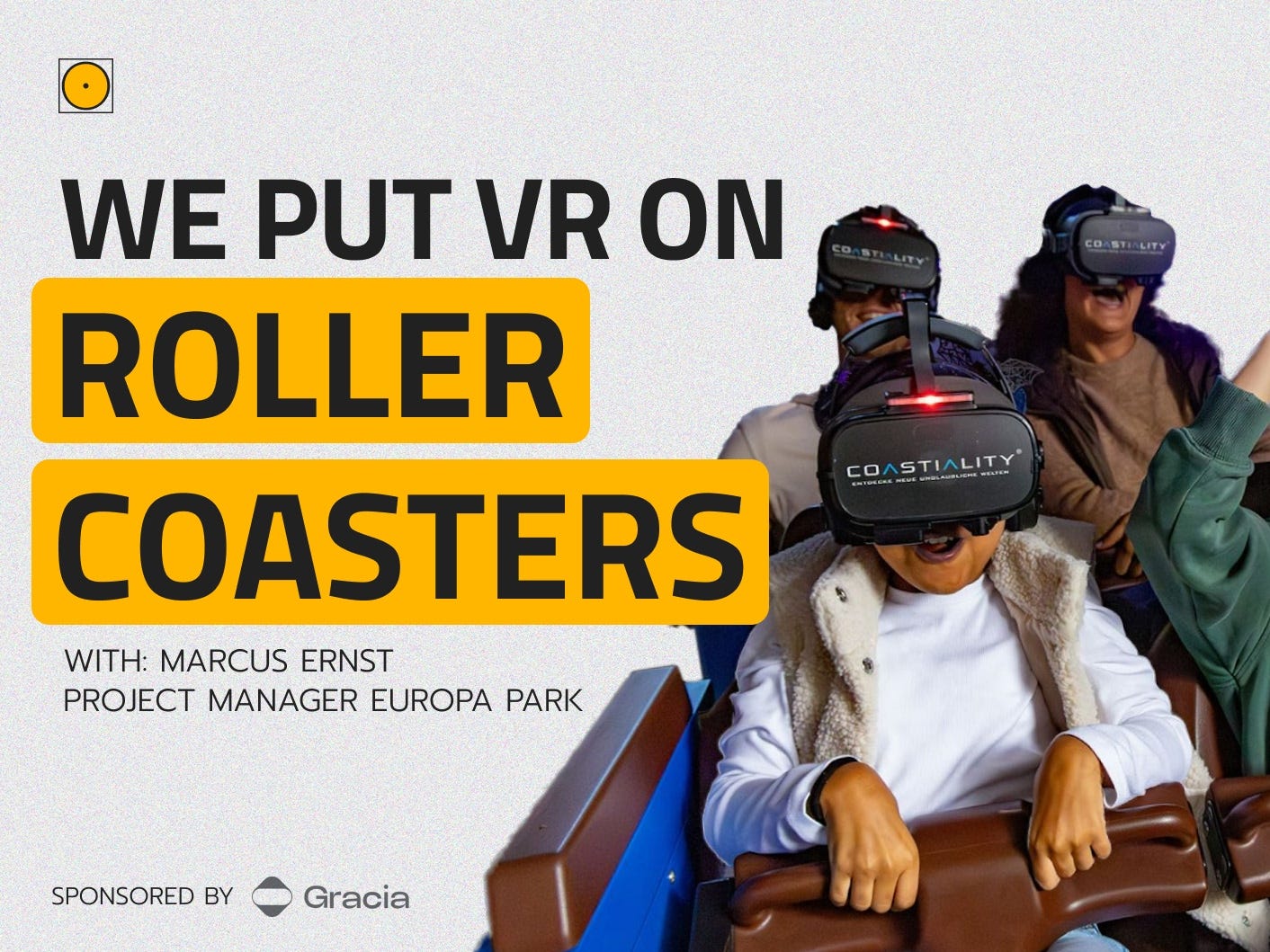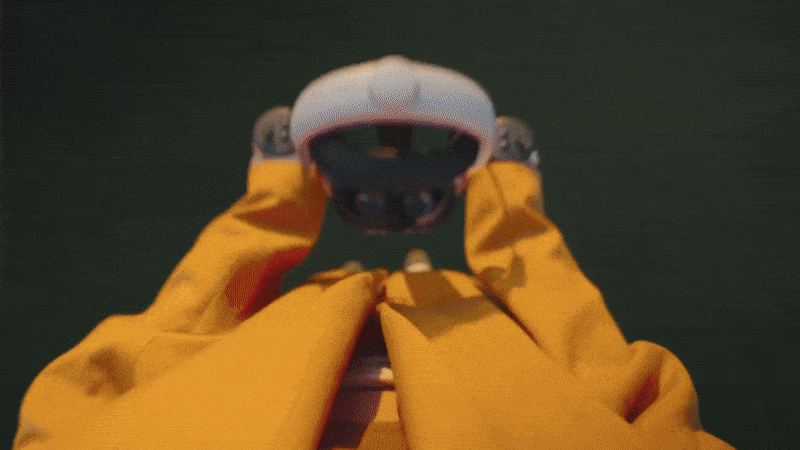What It Takes to Put VR on Rollercoasters 🎢
"We started in 2017 and since then we deployed VR to millions of visitors per year"
In this interview, Marcus Ernst, project manager at Mack One shares how he and his team brought XR to life in Europa Park, the second largest theme park in Europe. From the challenges of strapping VR to a roller coaster to building scalable free-roaming experiences, Marcus dives deep into what it takes to balance storytelling, technology, and operational efficiency at scale.
Before getting into the interview, I wanted to quickly introduce you to today’s sponsor Gracia AI. Gracia AI is the only app that allows you to experience Gaussian Splatting volumetric videos on a standalone headset, either in VR or MR.
It is a truly impressive experience and I recommend you to try it out right now on your Quest or PC-powered headset.
Interview with Marcus Ernst
What made you even think of putting a VR headset on a roller coaster back in 2017?
Marcus Ernst: It was honestly a pretty wild idea at the time. We didn’t have wireless headsets, so we started out using wired ones. I still remember developers sitting on the roller coaster with laptops strapped to them. It was kind of insane. But it came from a pure desire to do something new, something no one had done yet. We saw VR as a storytelling tool, and the roller coaster gave us this insane canvas.
What’s the most important metric when designing XR attractions in a theme park?
Marcus Ernst: Throughput. 100%. That was a lesson I learned very early, actually from Joe Rohde at Disney. He told me, “You can build the best attraction in the world, but it’s worth nothing if you can’t get people through it.” And it stuck with me. At Europa Park, we’re talking tens of thousands of people a day. If your XR experience slows down the line, people are frustrated, and that ruins everything. So we design with throughput in mind from the very beginning.
What kind of constraints does that create when it comes to the hardware you can use?
Marcus Ernst: Massive ones. For example, when we started looking into free-roaming VR, none of the headsets were built for 8–10 hour days, every day, all year. They just weren’t designed for theme park conditions. Also, we had to get people onboarded with the headset in 30 seconds. If you take longer than that, you're tanking your throughput.
What attractions at Europa Park currently use VR or XR elements?
Marcus Ernst: It’s evolved a lot. We started with a single roller coaster using a VR headset. Then we added a second one and built in a free-roaming pre-show while guests were still in the queue. From there, we went fully free-roaming; no ride, just people moving through a tracked space. Most recently, we’ve added a mixed reality experience on a trackless ride system. So we’ve really gone from bolting VR onto something that existed to designing entirely new experiences around it.
What headsets are you currently using, and which ones do you prefer?
Marcus Ernst: Honestly, we’ve used just about everything. But in terms of reliability for high-volume usage, HTC’s Vive Focus 3 has been a workhorse, especially because it supports swappable foam faceplates, which was essential during COVID. That said, we also use Pico (mainly the G4 and the Pico 4 Ultra) for mixed reality use cases. They offer great value and flexibility, which is super important when you’re operating at our scale.
Can you talk about the underwater VR experience and how that came about?
Marcus Ernst: That one’s close to my heart. It wasn’t even our idea at first, it came from a client who wanted to put VR on a log flume ride. But then we asked, why not take it even further? That’s when we created a diving theater experience using waterproof headsets. It was challenging, especially figuring out the right casing, but it gave us another way to push the limits of immersive tech. It’s not something people expect in water environments, and that surprise adds to the magic.
You’ve talked about your successes, but what about the failures? What didn’t work?
Marcus Ernst: Oh, so many. And we had to be okay with failing because someone has to be the first to try it. Syncing the VR visuals with roller coaster motion was a nightmare early on. Even being 20–40 milliseconds off can cause motion sickness. And we didn’t get that right on the first try. Then with free roaming, our first version was way too complicated. We were gamers, so we made a gamer’s experience, but most visitors are not. They were overwhelmed, and we had to drastically simplify.
What were the biggest learning curves moving from VR on rides to free-roaming experiences?
Marcus Ernst: It was a whole different beast. Rides have mechanical systems you can depend on. With free roaming, you’re guiding people through a space with no rails, literally and figuratively. So we had to invent our own systems for throughput. We looked at haunted houses and dungeons, those segmented experiences where groups move room to room. That inspired our sector-based model, which lets us stagger entry and keep the flow going. It’s storytelling meets logistics.
What was the “aha” moment behind creating the smaller, more streamlined UB-style experience?
Marcus Ernst: It came after we built the big 30-minute free-roaming attraction. We asked guests what they liked most, and it wasn’t the haptics or props—it was the freedom to move. So we stripped everything back to focus on that. We made it single-player, with a first-come, first-served model. No more waiting for groups to fill. It was simple: one entrance, one exit (and yet incredibly powerful). Now we’re seeing over a thousand people go through per day in Hamburg using that system.
You mentioned experimenting with mixed and augmented reality. Where do you see that going first?
Marcus Ernst: Honestly, it has to solve a problem or create something entirely new. We ask ourselves, “Is this the right medium for the story we want to tell?” Because otherwise, we’re just using tech for the sake of tech. One great use case is queues. Nobody likes waiting for two hours. AR can turn that into a pre-show. Or in dark rides, you can personalize the story through mixed reality without building new animatronics. But we always start with the story, not the hardware.
So why hasn’t mobile AR taken off in theme parks yet?
Marcus Ernst: It’s not a tech issue. The tech works. The problem is battery life. People are at the park for 8–10 hours, and AR drains your phone battery fast. If someone uses AR for an hour in line and their battery’s already at 40% before lunch, they’re going to be frustrated. That frustration outweighs the fun of the AR experience. We’ve tested AR activations and the feedback was positive, but until battery life improves or we start handing out power banks, it’s tough to scale.
What kinds of AI-powered attractions are you experimenting with right now?
Marcus Ernst: We're exploring a few things I can’t fully reveal yet, but the idea is real-time responsiveness. Think about a character in an attraction reacting dynamically to what a guest says or does. We’re looking at combining voice input with generative character dialogue to create unique interactions. It’s early days, but that level of adaptability could make every visit different and memorable.
What’s the mood in the industry when it comes to AI and immersive tech overall?
Marcus Ernst: The guiding principle is simple: give people something they can’t get at home. That's the bar. AI and immersive tech are exciting, but they’re only useful if they help us cross that bar. It could mean combining technologies in new ways or creating environments that adapt in real-time. But whatever it is, it has to be extraordinary. People are spending time and money to come here. We owe them something that no app or home device can replicate.
Last one: what keeps you excited about this space?
Marcus Ernst: It’s the feeling that we’re still only scratching the surface. The idea that we can turn something as traditional as a roller coaster or a queue line into a deeply immersive experience using the right tech, it still blows my mind. And working with pioneers through things like the AUREA Award keeps me inspired. Not everything will work, and that’s okay. The important thing is that someone tries it. That spirit of experimentation is what makes this job so exciting every single day.
Do not forget to check out the full interview on your favourite platform 👇
That’s it for today
See you next week




